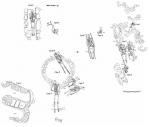Summary (English)
APOLLONIA – SOZOPOLIS (Petar Leshtakov – junior_1_bg@yahoo.com, Dimitar Nedev) A Late Neolithic stratum was explored in Sector West, containing debris and sherds. An oven was discovered. A stone axe and a serpentine pendant were found. A pit was explored, containing sherds from Greek amphorae and polychrome vessels and Thracian pottery of the second half of the 6th century BC. A sector of a water-conduit of the second half of the 4th century BC was discovered, consisting of 22 terracotta pipes, each one 70 – 73 cm long and 21 – 22 cm in diameter. Four rooms in a Late Roman villa were explored in the Central Sector. The walls were 70 – 80 cm wide, preserved up to 1 m in height. The floor was paved with bricks. A marble column base reused as spolia was documented with a votive inscription of the 1st – 2nd century AD “To Zeus, the god of my ancestors, the priest Tiberius Claudius Procles, son of Rhoemetalces (devoted)”. The finds comprised coins and sherds, including from amphorae. The villa dated to AD 325 – 500. During the second construction period in the 5th century AD, two rooms were added to the building. A cistern was discovered at 7.40 m to the south of the villa, built of roughly-cut stones bonded with mortar and 4.10 m by 2.85 m in size. Ten graves were explored in Sector East. Seven of the graves (two containing two dead each and five single) probably dated to the 4th century AD and five of them were Christian burials. Three of the graves (one of an adult and two of children) were Christian and dated to the 15th – 17th centuries. A fragment from a roof-tile with a graffito that reads: IC XC NI KA, was discovered on the skull of the dead in Grave No. 3 and a coin was found in one of the child burials. Three ovens of the second half of the 5th century AD were discovered. Six pits were explored, containing sherds of the end of the 6th – 5th centuries BC.
- Petar Leshtakov - Archaeological Institute with Museum
- Dimitar Nedev - Archaeological Museum in Sozopol
Director
Team
Research Body
- Archaeological Institute with Museum
- Archaeological Museum in Sozopol






![Download [PDF]](/excavation/skins/fasti/images/results/download_sml.png)

